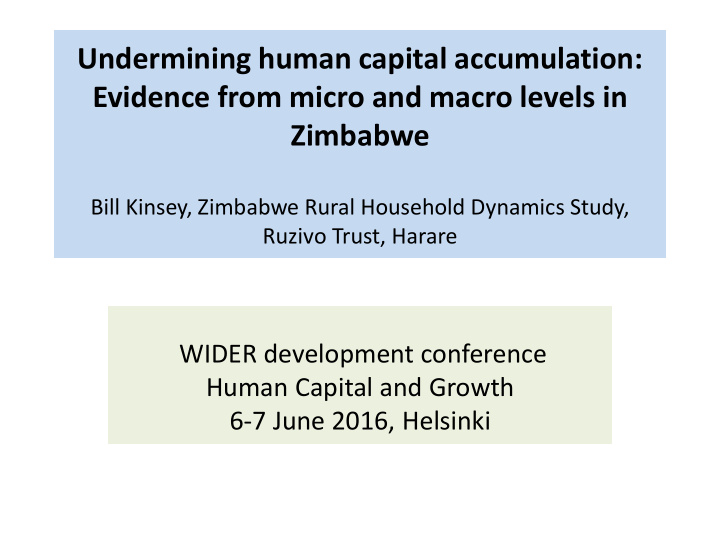



Undermining human capital accumulation: Evidence from micro and macro levels in Zimbabwe Bill Kinsey, Zimbabwe Rural Household Dynamics Study, Ruzivo Trust, Harare WIDER development conference Human Capital and Growth 6-7 June 2016, Helsinki
Objective • To understand the impact of preschool undernutrition on subsequent human capital formation • To estimate the lifetime income loss of individuals affected by chronic undernutrition as children • To estimate the national economic costs of the failure to address child undernutrition
The data • Rural households (land-reform beneficiaries & “control” communities) • Long-term panel study (1983-84, 1987, 1992- 2001, 2007-08, 2010, 2012) • Anthropometric assessments on <6s (and their parents) & later educational attainments • Data capture effects of violent conflict, repeated droughts & the advent of HIV/AIDS
Findings • Children aged 12 - 24mo lose 1.5 - 2.0cm of linear growth following drought • There is only a limited catch-up effect • So growth faltering has a permanent effect
Findings, continued • Better height-for-age in preschoolers is associated with increased height as adolescents and years of schooling completed • If a representative child in the sample had the stature of a median child in a HIC, by adolescence the child would be 3.4cm taller, have completed an additional 0.85 years of school and would have begun school six months earlier
Rates of return to education Years of schooling Per cent Zimbabwe SSA Primary 7 5.4 Secondary 19 10.8 Post-secondary 31 17.0 Average years of 9 n/a education Average rate of return 16 n/a Source: Bigsten et al . (2000) & Appleton et al . (1996)
What is a shock, 1? 45 40 35 30 25 20 15 10 5 0 Nationally representative data Panel data
What is a shock, 2? Year Mean HAZ % <-2.00 Mean HAZ 1984 -1.39 33.0 -3.06 1987 -1.15 24.9 -2.89 1992 -1.41 28.0 -2.98 1993 -1.60 38.6 -2.98 1994 -1,25 30.6 -3.00 1995 -1.48 34.0 -2.88 1996 -1.67 38.1 -3.12 1997 -1.36 33.6 -2.86 1998 -1.46 33.0 -2.91 1999 -1.47 33.1 -2.90 2000 -1.49 33.9 -2.82
Shocks? Percentage of rural children of school-entry age who enter the first grade of primary 70.6 school Percentage of children of secondary school age currently attending secondary school or 47.7 higher Source: Unicef MICS 2014, pp32-3
Working conclusions • What we have is not a series of shocks, the much-beloved natural experiments, but a national pandemic with milder & more severe manifestations. • The same patterns are repeated in much/most of rural sub-Saharan Africa. • The underlying causes will not be addressed by food security, consumption-smoothing, or the other conventional “remedies.”
Thank you!
Recommend
More recommend